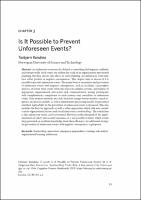Chapter 3 Is It Possible to Prevent Unforeseen Events?
Abstract
"An unforeseen event may be defined as something that happens suddenly
and unexpectedly. Such events are seldom the result of an organisation’s operational
planning, but they can be side-effects of such planning. An unforeseen event may
have either positive or negative consequences. This chapter aims to discuss if it is
possible
to prevent unforeseen events. The major focus is on analysis and prevention
of unforeseen events with negative consequences, such as accidents, catastrophes
and acts of terror. Such events often take place in complex systems, and failures of
appropriate organisational interaction and communication among participants
with complementary competence in such systems may contribute to unforeseen
events. Risk-analysis methods and tools based on energy-barrier models, causal sequence
and process models, as well as information-processing models are presented
and their applicability to the prevention of unforeseen events is discussed. This also
includes the Bow-tie approach, as well as other approaches which take into consideration
organisational factors and social interaction (samhandling). The conclusion
is that unforeseen events can be prevented. However, in the aftermath of the implementation
of safety and security measures, it is not possible to know which events
they prevented, or to obtain knowledge about their efficiency. An additional strategy
for prevention of unforeseen events with negative consequences is proposed."
Keywords
Samhandling; interaction; emergency-preparedness; training; risk analysis; organisational learning; unforeseenDOI
10.23865/noasp.36.ch3OCN
1076723288Publisher website
https://www.cappelendamm.no/Publication date and place
Oslo, 2018Classification
Society and Social Sciences
Warfare and defence
Military and defence strategy


 Download
Download